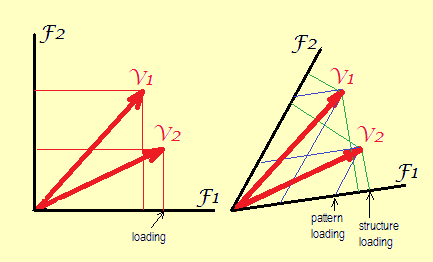Let me recommend you first to read this Q/A. It is about rotations and can hint towards or partly answer your question.
A more specific answer from me about interpretation might be as follows. Theoretically, factor of Factor analysis is a univariate latent feature, or essence. It is not the same thing as a set or cluster of phenomena. Term "construct" in psychometry is generic and could be conceptualized as factor (essence) or cluster (prototype) or something else. Since factor is univariate essence it should be interpreted as the (relatively simple) meaning lying on (or "behind") the intersection of the meanings/contents of the variables loaded by the factor.
With oblique rotation, factors are not orthogonal; still, we usually prefer to interpret a factor as clean entity from the other factors. That is, ideally, factor X label would dissociate from a correlated factor Y label, to stress individuality of both factors, while assuming that "in outer reality" they correlate. Correlatedness thus gets to be an isolated characteristic of entities from the labels of the entities.
If it is this the strategy typically preferred then pattern matrix appears to be the main tool for interpretation. Coefficients of pattern matrix are the unique loads or investments of the given factor into variables. Because it is regression coefficients$^1$. [I insist that it is better to say "factor loads variable" than "variable loads factor".] Structure matrix contains (zero-order) correlations between factors and variables. The more two factors X and Y correlate with each other the greater can be the discrepancy between the pattern loadings and the structure loadings on some variable V. While V ought to correlate higher and higher with both factors, the regression coefficients can rise both or only one of the two. The latter case will mean that it is that part of X which is different from Y what loads V so much; and thence the V-X pattern coefficient is what is highly valuable in interpretation of X.
Weak side of pattern matrix is that it is less stable from sample to sample (as usually regression coefficients in comparison to correlation coefficients). Relying on pattern matrix in interpretation requires well planned study with sufficient sample size. For pilot study and tentative interpretation structure matrix might be better choice.
Structure matrix seems to me potentially better than pattern matrix in back interpretation of variables by factors, if such a task arises. And it can rise when we validate items in questionnaire construction, - that is, decide which variables to select and which to drop in the scale being created. Just remember that in psychometry common validity coefficient is correlation (and not regression) coefficient between construct/criterion and item. Usually I include an item in a scale this way: (1) look at maximal correlation (structure matrix) in the item's row; (2) if the value is above a threshold (say, .40), select the item if its situation in pattern matrix confirms the decision (i.e. the item is loaded by the factor - and desirably only by this one - which scale we're constructing). Also factor scores coefficient matrix is what is useful in addition to pattern and structure loadings in the job of selection items for a factor construct.
If you do not perceive a construct as univariate trait then using classic factor analysis would be questioned. Factor is thin and sleek, it is not like pangolin or armful of whatever. Variable loaded by it is its mask: factor in it shows through what appears to be completely not that factor in it.
$^1$ Pattern loadings are the regression coefficients of the factor model equation. It the model, the being predicted variable is meant either standardized (in a FA of correlations) or centered (in a FA of covariances) observed feature, while the factors are meant standardized (with variance 1) latent features. Coefficients of that linear combination are the pattern matrix values. As comes clear from pictures below here - pattern coefficients are never greater than structure coefficients which are correlations or covariances between the being predicted variable and the standardized factors.
Some geometry. Loadings are coordinates of variables (as their vector endpoints) in the factor space. We use to encounter those on "loading plots" and "biplots". See formulas.
Left. Without rotation or with orthogonal rotation, axes (factors) are geometrically orthogonal (as well as statistically uncorrelated) to each other. The only coordinates possible are square like what are shown. That is what is called "factor loading matrix" values.
Right. After oblique rotation factors are no longer orthogonal (and statistically they are correlated). Here two types of coordinates can be drawn: perpendicular (and that are structure values, correlations) and skew (or, to coin a word, "alloparallel": and that are pattern values, regression weights).
["Perpendicular" and "skew" have been my labels. At one point later I've learned that in math jargon, the perpendicular coordinates are called covariant ones or projection ones, and the skew coordinates are called contravariant ones or parallel-axis ones].
Of course, it is possible to plot pattern or structure coordinates while forcing the axes to be geometrically orthogonal on the plot - it is what when you take the table of the loadings (pattern or structure) and give to your software to build a standard scatterplot of those, - but then the angle between the variable vectors will appear widened. And so it will be a distorted loading plot, since the aforesaid original angle was the correlation coefficient between the variables.
See detailed explanation of a loading plot (in settings of orthogonal factors) here.

